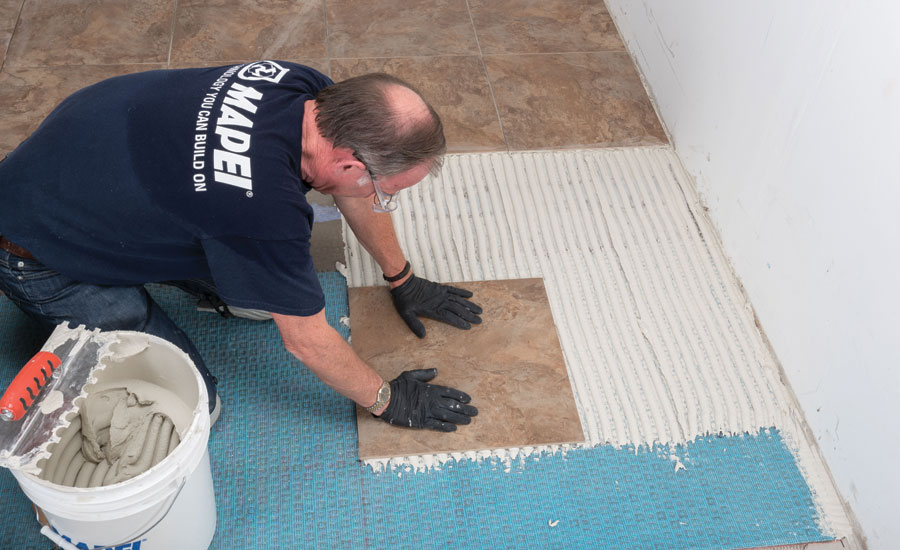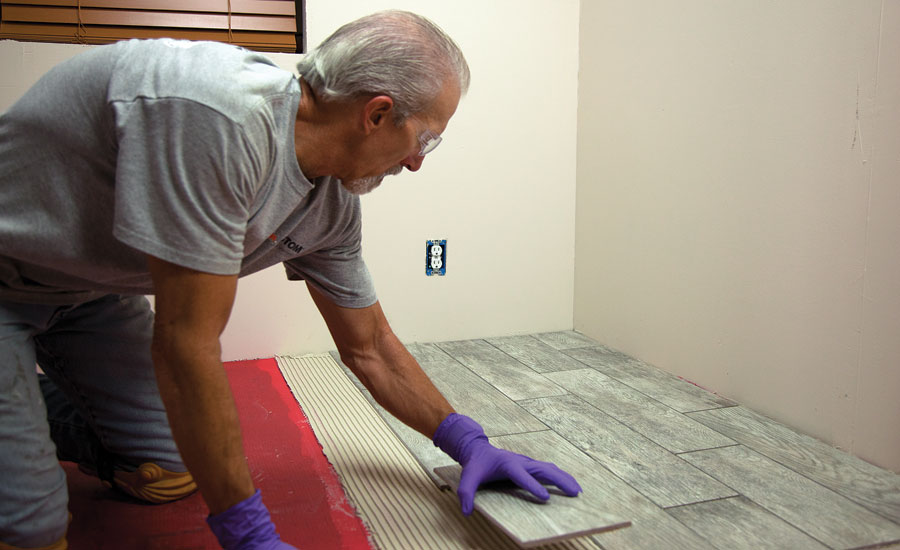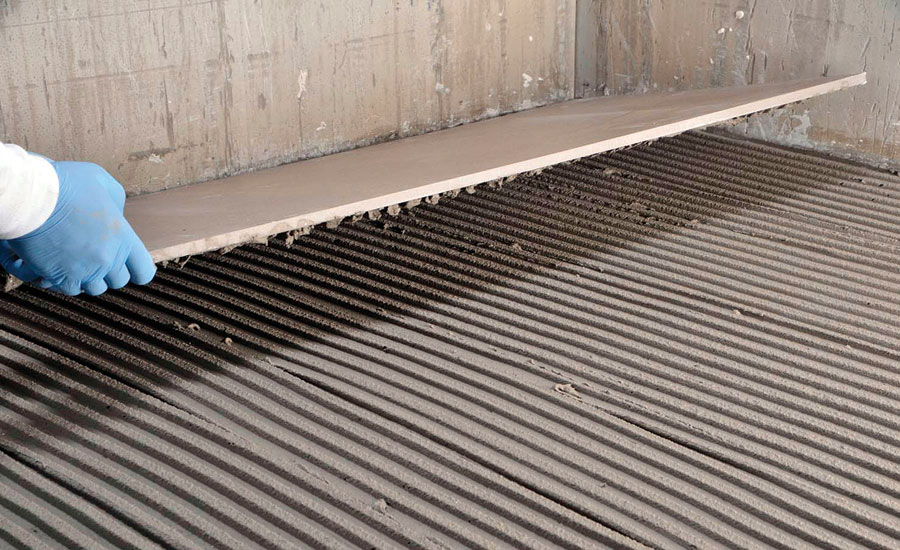Installing Large-Format Ceramic Tile: Understanding Prep, Products

MAPEI’s Ultraflex LHT mortar can be used in both floor and wall applications.

Laticrete LHT mortar can be built up to 1/2" without shrinkage, the company says.

Ardex’s N 23 rapid-set product can allow grouting in two hours, but still offers 30 minutes of open time for installers to place large and heavy tiles, according to the company.

Working with Custom Building Products’ ProLite Premium Large Format Tile Mortar.

Working with the fast-setting Ceramabond MBFS mortar from Texrite.





One trend is undeniable in the tile industry, and that is the explosive growth of large-format tiles (defined as any tile with one edge greater than 15", according to the Tile Council of North America). As tile sizes continue to expand, they present a unique set of challenges to contractors and installers, including the need for an even flatter substrate, increased potential for lippage and different techniques needed for working with the mortar.
Article Index:
Preparing the substrate
Steve Taylor, Custom Building Products director of technical and architectural marketing, put it simply. “Large and heavy tile (LHT) mortars, previously called medium-bed mortars, are for installing tile. They are not for correcting variations in the substrate.”
Brian Pistulka, MAPEI business development manager, echoed these sentiments. “LHT mortars are not intended for truing or leveling substrates or the work of others. They are not intended to be used where substrate variations exceed the limitations of the mortar. Substrate preparation prior to installing tile with LHT mortars is key to a quality installation.”
Michelle Swiniarski, Bostik’s ceramic installation systems market manager, cautioned that without taking the proper time to prepare the substrate, lippage and cracking may occur. “Extra care must be taken to patch low areas and grind high areas. To ensure a completely flat floor, a self-leveling underlayment is best. Instead of the typical tolerance of 1/4" in 10 ft., a 1/8" in 10 ft. tolerance is recommended, and no more than 1/16" in 12 ft.”
Using the mortar
Taylor noted that Custom’s VersaBond-LFT is a modified dry-set mortar specifically designed for large-format tile installations on floors. It features non-slump properties “to help eliminate lippage and promote flat, level floor tile installations over a variety of substrates.”
He recommends using a 1/2" by 1/2" by 1/2" square-notch trowel or 3/4" by 9/16" by 3/4" U-notch trowel. “Back-buttering is suggested to achieve 80% mortar coverage in dry areas and 95% coverage in wet areas. Trowel ridges for all mortars should go in one direction, with no swirls. Ridges should be collapsed by rocking the tile back and forth against the ridges.”
The company also offers Complete Contact LFT, an LHT mortar for expansive spaces. “It’s a unique solution because of its flowable properties that reduce the need to back-butter tile,” Taylor explained.
Alan Kin, Texrite sales/technical, said the advantages of LHT mortars (including the company’s Totalcontact mortar) are their increased viscosity and soft, paste-like body when troweled. “The new LHT mortar types will resist the increased tile weight of larger pieces and are formulated to resist sag/slump, with shrinkage compensation when curing.”
These mortars can be used with large-format square tiles as well as large, long tile planks. When working with these mortars, always use the “straight line” troweling method, Kin noted. “Straight line toweling allows air to escape and better collapses the adhesive when the tile is moved back and forth against the ridges to close and fill the bond. The end result of straight line troweling is 95% to 100% bond contact. Better contact supports the tiles and eliminates any hollow sounds.”
MAPEI’s newest LHT mortars include two polymer-modified products: Ultraflor Plus and Ultraflex LHT. Pistulka explained them both. “Ultraflor Plus is for large-format and heavy tile and stone in floor applications. Ultraflex LHT is for large-format and heavy tile in wall applications, and large-format and heavy tile and stone in floor applications. Both products are for thicker bond coats from 3/32" to 1/2" and offer a smooth and creamy consistency for easy application.”
He said LHT mortars are formulated for thicker bond coats for several reasons. “For large tile, a thicker bond coat is required to achieve mortar coverage requirements if there is warpage in the tile. Also, thicker bond coats eliminate voids under the tile where curvature exists.”
Ardex’s LHT products include Ardex X 77 Microtec Fiber-Reinforced Tile and Stone Mortar for large-format tile installations, Ardex X 78 Microtec Semi-Pourable Tile and Stone Mortar for floors, and Ardex N 23 Microtec Rapid Set Natural Stone and Tile Mortar for natural stone installations.
According to Russ Gaetano, Ardex tile and stone installation systems marketing manager, “Ardex X 77 and X 78 offer a 60-minute open time, allowing for more mortar to be placed on the substrate and more time to place larger, more difficult tiles. Additionally, Ardex X 78 is a full-coverage mortar, often eliminating the need to back-butter large-format tile being placed on floors.”
He added, “Ardex N 23 has self-drying technology that prevents staining and warping of sensitive, large-format natural stone tile. Although it is a rapid-set where you can grout in two hours, there is a 30-minute open time to allow for large tile to be placed before the mortar skins over.”
Bostik’s best mortar for installing large-format tile is Reflex Ultra-Premium Polymer-Modified Mortar, Swiniarski explained.
“Bostik’s Reflex mortar was developed years ago and has stood the test of time with no need to redevelop a mortar [specifically] for installing large-format tile. Bostik understood many years ago the need for a long open time, to allow time for the installer to back-butter a tile or to properly position large and heavy tiles. It also remains semi-fluid, which allows it to fill in voids and allow continuous mortar coverage.”
Laticrete offers Laticrete LHT, a large and heavy tile mortar that can be built up to 1/2" without shrinkage according to Laticrete’s senior director of technical services, Arthur Mintie.
Other considerations
According to Gaetano, the biggest challenge in working with large and heavy tile is getting it placed. “The physical size and weight of these tiles makes them more difficult and cumbersome for installers to transport and handle.”
Additionally, when installing on walls, “larger, heavier tiles often require some type of mechanical support if there is not enough sag resistance in the mortar.”
When working with large and heavy tiles, Gaetano recommends “following the tile manufacturer’s recommendations, long open times and excellent sag resistance in the mortar, and [time to develop] project experiences and success with large-format tile installations.”
Mintie noted that large-format tile becomes even more cumbersome when trying to create an intricate look like a herringbone or brick pattern offset. Lippage is also exacerbated when working with these unique patterns “as there are more corners to align that must be compensated for.”
Some large-format tiles might also experience greater facial warpage. “This challenges the installer’s ability to create a flat and even surface. In some cases, installers may choose to use a mechanical edge-leveling system to achieve the desired result.”
When choosing a mortar for large and heavy tiles, Mintie added, “I recommend contractors look for complete installation systems from an adhesive manufacturer. The best systems are backed by a comprehensive warranty. Look for products offering ease of mixing, spreading, bedding and support. Typically, these mortars are creamier and fluffier than traditional thin-set mortars.”
Swiniarski noted that an unanticipated challenge of working with large and heavy tile is scoring and cutting it. “It can leave an uneven edge depending on the tile type. It is best to invest in a premium-quality wet saw and take your time while making the cut. While drilling it may be best to use cool water, especially with porcelain, to avoid cracking. For some tiles, suction cups may be used to facilitate placement of tiles and reduce breakage/cracking.”
She added, “An installer should look for a premium mortar that allows time to back-butter and position large tiles as needed. A premium mortar maintains moisture in the mortar itself. This prevents large tiles from extracting excessive moisture from the mortar system, which may lead to premature dehydration, cracking or poor adhesion.”
More Thoughts on LHT
Alan Kin of Texrite is obviously passionate about the topic of large and heavy tile (LHT) installation. Long after he had responded to our original questions, he sent an email with even more thoughts on working with LHT. We thought there was enough good information for our readers in his extended responses to warrant this sidebar.
Mortar selection
“Texrite has developed several mortar products for large format tile that allow a setting mortar bed up to 3/4" in thickness. These allow an installer a thicker bond coat application without mortar shrinkage and lippage.
“Each mortar has been chemically modified for a thick body to prevent slump while still maintaining a creamy spreadable/trowelable texture. With five different mortar products from Texrite, the degree of product selection allows better cost efficiencies to match jobsite and ANSI (A118.11, A118.4, A118.1) demands.
“Texrite’s Totalcontact is our highest-performance bond mortar with no sag and both floor and wall application properties. Two other professional-grade products—Texrite’s Ceramabond MB and faster-setting version called Ceramabond MBFS—are used on all the general surfaces that the builder trades encounter on an industrial, commercial or public facility jobsite. Installers needing a latex-polymer mortar for interior/exterior large-format tile over concrete slabs, cement backer-boards or drywall can select Texrite’s Porcelain MB mortar. Those needing a non-modified mortar for uncoupling mat installation can use Texrite’s Floor Mix MB bond mortar.”
Installation challenges
“Where most installers are traditionalist in mindset and often do not openly accept change in adhesive mortar practices, there needs to be a better understanding that larger-format tiles have changed installation. Do not allow past tiling experience or prior mentorship allow you to make the mistake of setting large-format tile in a thin set manner. Slab surface conditions are more critical and large-format tiles will require more mortar and different type to properly set them.
“Larger-format tiles in excess of 15" act as a straight edge across floors/substrate and experience a larger mortar bond gap. All ceramic and porcelain tile in excess of 15" will have some type of crown or slight arch effect due to the tile kiln/firing process, which further increases the mortar bond gap.
“Exceeding thin set application recommendations promotes shrinkage and increases the likelihood of tile lippage or uneven settlement/sag after placement, when using a thin set mortar. End-customer and design layout are not universal in the understanding for 1/3 maximum tile offset for staggered joint patterns, which especially in large-format and plank tiles is critical to [reduce] lippage.
“All levels of tiles sales, design layout and installation need to be aware of the 1/3 tile joint staggering before a large-format tile installation. There is nothing to adjust, and no correction or fix that can be done after full installation. The tile installer can help advise or inform before installing, but cannot be the catch-all for the final finish in these more than 33% offset tile layout situations, any more than tile & grout color selection. Texrite distributes technical bulletins and conducts training lecture/sessions for avoiding these types of situations.”
Final thoughts
“The old practice of applying more thin set to fill the increased bond gap beneath 15" and greater tiles exceeds the design mix of thin-set mortars (nominal 3/32" bond coat, with a maximum thickness of 1/4"). These larger tiles (square, rectangular and/or plank tile sizes) have a mortar bond thickness more typical of 1/2" beneath the tiles. Products designed for LHT-setting mortars are not a selling ploy or marketing scam, but an actual installation tool to address the increased bond gap of the substrate to the tile.
“As the tile size increases in any single dimension, so increases the proper mortar thickness from 1/4" up to 3/4". Installation personnel will need to recognize, specify, bid and use large-format tile mortars when installing these type of jobs.”
Looking for a reprint of this article?
From high-res PDFs to custom plaques, order your copy today!













